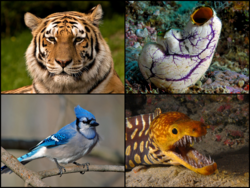Los olfatores (Olfactores) son un clado de animales que incluye a los vertebrados y los urocordados. Basado en estudios genéticos como la secuencia de ADN y otros elementos genéticos.[1][2] La teoría tradicional consideraba que los cefalocordados estaban más emparentados con los vertebrados debido a algunas similitudes morfológicas.[3] El término olfactores proviene del latín olfactus ("olfato"), debido al desarrollo de la faringe para incluir funciones respiratorias, en contraste con la falta de sistema respiratorio y órganos sensoriales especializados vistos en cefalocordados como la lanceta.[4]
Filogenia
El siguiente cladograma muestra las relaciones filogenéticas entre los deuteróstomos en base a la hipótesis de los olfatores:[5][6]
| Deuterostomia |
| ||||||||||||||||||||||||||||||
Referencias
- ↑ Delsuc, F (2006). «Tunicates and not cephalochordates are the closest living relatives of vertebrates.». Nature 439 (7079): 965-968. Bibcode:2006Natur.439..965D. doi:10.1038/nature04336.
- ↑ Dunn, C.W. «Broad phylogenetic sampling improves resolution of the animal tree of life.». Nature 452.
- ↑ Stach, Thomas (2008). «Chordate phylogeny and evolution: a not so simple three‐taxon problem». Journal of Zoology 276 (2).
- ↑ Benton, M.J. (14 de abril de 2000). «Vertebrate Palaeontology: Biology and Evolution.». Blackwell Publishing.
- ↑ Philippe, Hervé; Poustka, Albert J.; Chiodin, Marta; Hoff, Katharina J.; Dessimoz, Christophe; Tomiczek, Bartlomiej; Schiffer, Philipp H.; Müller, Steven; Domman, Daryl; Horn, Matthias; Kuhl, Heiner; Timmermann, Bernd; Satoh, Noriyuki; Hikosaka-Katayama, Tomoe; Nakano, Hiroaki; Rowe, Matthew L.; Elphick, Maurice R.; Thomas-Chollier, Morgane; Hankeln, Thomas; Mertes, Florian; Wallberg, Andreas; Rast, Jonathan P.; Copley, Richard R.; Martinez, Pedro; Telford, Maximilian J. (2019). «Mitigating Anticipated Effects of Systematic Errors Supports Sister-Group Relationship between Xenacoelomorpha and Ambulacraria». Current Biology 29 (11): 1818-1826.e6. ISSN 0960-9822. PMID 31104936. doi:10.1016/j.cub.2019.04.009.
- ↑ Kapli, Paschalia; Telford, Maximilian J. (11 Dec 2020). «Topology-dependent asymmetry in systematic errors affects phylogenetic placement of Ctenophora and Xenacoelomorpha». Science Advances 6 (10). doi:10.1126/sciadv.abc5162. Consultado el 17 de diciembre de 2020.

